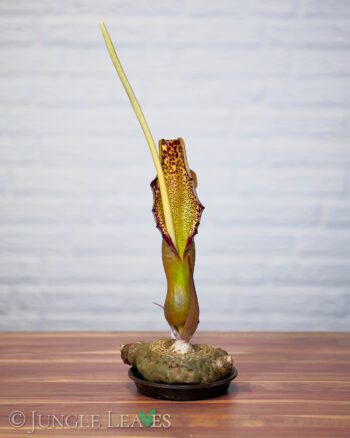Epipremnum aureum ‘Manjula’ (golden pothos)
8,99€ incl. VAT
Beautiful cultivated form of the classic pothos with more and brighter variegation. Absolutely robust.
- Description
- Care
- Additional information
Description
Description
Golden pothos, Epipremnum aureum is an uncomplicated and easy grower for almost any site and does well with low light and drought. The cultivar ‘Manjula’ is characterized by a larger proportion of variegated leaf area and this is also whitish green rather than yellow, giving it an overall much brighter appearance.
Originally this species probably comes from the island of Mo’orea, part of French Polynesia. However, it has since been spread by humans to tropical and subtropical areas worldwide, where it has become an invasive species. Today they can be found from South America to Africa, Asia and Australia. Because of its extreme robustness, it can grow almost anywhere where it is frost-free all year round. The natural form of golden pothos shows a yellow variegation! This is not a human selected cultivar. There are of course numerous cultivars of it, where special plants have been selected for their variegation, e.g. ‘Neon‘, ‘N’Joy‘ or the ‘Manjula’ offered here and others, but also the natural form already has variegated leaves.
Due to a genetic defect, this plant blooms extremely rarely. Probably the original population, from which all specimens cultivated today are descended, can be traced back to a single mother plant, which was variegated and has since then only reproduced vegetatively.
Like most Epipremnum, golden pothos grows very large if it can climb. The adult leaves can grow up to 80cm long and 60cm wide and are pinnate. They then resemble the leaves of adult Monstera.
You will receive a strong plant with several stems in a 12cm pot.
Care
500 cm
150 cm
Partial shade
18 – 30 °C
50 – 90 %
This plant grows as a so-called hemi-epiphytic vine in the understory of rainforests.
As a young plant, it grows along the ground until it finds something to climb, usually a tree. At this stage of life it is small, can cope with very little light and has rather inconspicuous leaves. Once it has found a tree, it grows up the tree, clinging to it with aerial roots. From now on it needs more light and less moisture. Only then will it develop the leaves typical of the species, which are also much bigger.
This rather special way of life should be imitated in order to ideally maintain it. It sounds a bit complicated, but it’s really not.
- Location/Light: This plant likes a lot of light, but not full midday sun. It likes a location with bright but indirect light best, for example, placed directly by a west/east window or placed slightly off to the side near a south window. A little direct morning sun, or in winter a little more direct sunlight is not harmful. However, you should be careful that this does not damage the leaves. Especially after prolonged cloudy periods, direct sunlight can “burn” the leaves.
This species will only form its adult leaves if it has both enough light and a support to climb on. This can be, close to nature, a tree trunk, but also any other reasonably rough surface, e.g. a wooden board, brick or even wallpaper (be careful: the roots cling very tightly and leave traces!). If the aerial roots dry out before they reach the support, you can also use a so-called “moss pole”, which holds more moisture. In any case, the location should be chosen so that you have enough space upwards for such a climbing aid.
- Temperature/Humidity: This plant comes from a tropical climate and naturally grows best in tropical temperatures and humidity. However, it is also very tolerant of “regular” conditions in an apartment.
It should not be below 18° C at night and at least 20° C during the day. It should not be exposed to temperatures above 32° C for prolonged periods.
The relative humidity of the air should be 50% or more. Especially in winter it should be protected from dry heater air to avoid unsightly dry leaf edges.
- Water/Fertilizer: This plant likes it less wet than one would assume for a rainforest species. The substrate should never dry out completely, but it should definitely not be really wet for a long time, this can damage the roots! So better to water a little less, and in between let at least the surface dry. How long this takes varies depending on the location, pot size and also season! Therefore, watering should never be strictly on schedule, but when it is necessary.
Watering both from above and from below (through a saucer or similar) is possible and equally effective. Watering can be with moderately hard tap water, rainwater or distilled water.
Fertilizing should be done during the main growing season, from about May to September. If you do not provide additional lighting, this plant will not grow much, if at all, from October to April, and does not need to be fertilized. No special fertilizer needs to be used. A regular complete fertilizer (N-P-K + trace elements) for indoor plants is sufficient. Liquid fertilizers, fertilizer sticks or similar are all suitable and can be used according to the manufacturer’s instructions. For young plants, which are not yet climbing, fertilize less (halve manufacturer’s instructions).
- Substrate/Pot: Pot this plant in a very loose, acidic (pH below 7), air-permeable and nutrient-poor mix that mimics rainforest soil. For this purpose, you can use a special substrate made of pieces of bark, sphagnum moss, perlite, coco coir and wood fiber. Either mix it yourself, or buy our ready-made Aroid Mix in a practical 7.5L bag!
The pot for this plant does not need to be very big, but should be chosen so that it does not dry out too quickly. However, the pot should also not be too big, otherwise it will not be evenly moist. This leads to the substrate already being dry at the top, but still wet at the bottom. Then you think you have to water again and drown the plant, which in reality is still moist enough. Some experimentation is required for the right pot size. As a guide, if you can water about every 5 to 10 days, and the substrate is almost completely dry in between, the size is well chosen.
Additional information
Additional information
| Weight | 0,4 kg |
|---|---|
| Dimensions | 12 × 12 × 30 cm |
| Will be shipped as | potted plant |
| pot size | 12cm pot |














